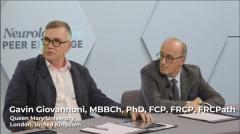
BTK Inhibitor Overview
Amit Bar-Or, MD, FRCPC, provides an overview of the history of BTKi’s as well as what makes this class of drug a promising target for relapsing and remitting forms of MS.
Episodes in this series

Jiwon Oh, MD, PhD, FRCPC: Hello, and welcome to this NeurologyLive® Peer Exchange titled, “Novel Mechanisms of Action in Multiple Sclerosis [MS]: Focus on BTK [Bruton's tyrosine kinase] Inhibitors.”
My name is Dr Jiwon Oh, and I'm the medical director of the Barlow Multiple Sclerosis program at St. Michael's Hospital at the University of Toronto, and joining me today in this discussion are 4 of my colleagues that I'll introduce you to.
Dr Gavin Giovannoni is professor of neurology at Queen Mary University of London in the UK. Dr Amit Bar-Or is the director of the Centre for Neuroinflammation and Neurotherapeutics and Chief of the MS Division at Penn Medicine, which is in Philadelphia in the United States. Dr Christophe Salmage is a professor at the University of Wormia and director of the Centre of Neurology in Lodz, Poland,and Dr Patrick Vermesh is the head of the University of Leal's Department of Neurology in Leal, France. Our discussion today will focus on the immune mechanisms that contribute to the pathophysiology of multiple sclerosis.
We will take a deep dive into Bruton's tyrosine kinase inhibitors, which block the actions of B cells and may affect other cell types that can facilitate inflammation. We will review key clinical data on BTK inhibitors in MS and discuss how to incorporate these novel agents into the treatment of people with MS once they become available.
Welcome, everybody, and let's get started.
I'm going to ask Dr Bar-Or the first question. Can you give us a short history lesson on BTK inhibitors and how they came to be, and also what makes BTKi[BTK inhibitors] a promising target for relapsing, as well as progressive forms of MS?
Amit Bar-Or, MD, FRCPC: Sure, Dr Oh. The history is pretty interesting. In the early 1950s, Dr Bruton described an 8-year-old boy with recurrent pneumococcal sepsis, and subsequently, in the 1990s, it was discovered that this mutation was in the BTK molecule, downstream of the B cell receptor. This turns out to be the case, the index case of X-linked agammaglobulinemia. This child and others like him had a selective loss of IgG [immunoglobulin G] with intact proteins otherwise in the serum, and this led to the appreciation that BTK is a key molecule downstream of the B cell receptor, which is also necessary in its action for survival of B cell malignancies.
There was a lot of interest in developing agents that could inhibit BTKis. The initial one was pretty nonselective with a lot of off-target effects, and the first more selective, not fully selective, but somewhat more selective one was ibrutinib, which was discovered in 2007 and is approved from several different B cell malignancies, including CLL [chronic lymphocytic leukemia].
The interest in MS in particular is, as we have done in the past, borrowed from the cancer world, and the rationale is that we've appreciated B cells, which is of course very important in terms of relapse biology. The idea here would be with a nondepleting approach to try to impact the capacity of B cells to contribute to MS disease activity, both in the periphery and potentially in the CNS [central nervous system] if these molecules can penetrate. As you pointed out, the other cell type in which BTK plays an important role is the myeloid cell population, which in the periphery includes macrophage and dendritic cells, but in the CNS would also include microglial cells. The prospect of BTK inhibition in MS to impact both relapse-related biology in the periphery, as well as CNS compartmentalized inflammation of both infiltrating B cells and macrophage, but also resident microglia.
Jiwon Oh, MD, PhD, FRCPC: Thanks, Dr Bar-Or. Along those lines, Dr Bar-Or did go over some of the processes that BTK inhibitors may help with MS, but how could they potentially address the unmet needs that we currently have clinically?
Gavin Giovannoni, MBBCh, PhD, FCP, FRCP, FRCPath: Over the last 10 years, we've realized that suppressing focal inflammatory activity is not sufficient to control MS, so people who are free of relapses in MRI activity often get worse. The process that driveswhat I refer to as small ring MS, often CNS related, and inside the CNS compartment, is a B cell population, and because of the current monoclonal antibody or the antiCD20s don't get in, the advantage is the BTKis will get in and potentially inhibit the CNS B cell compartment.
The other one that Dr Bar-Or referred to is the microglial response. We know that microglia in the chronic active lesions may be driving, worsening, be it perivascular rim lesions or slowly expanding lesions, and inhibiting those microglia may actually impact on the small ring pathology. There are 2 potential targets within the central nervous system.
The third one is Epstein-Barr virus [EBV], as you're probably aware; it looks like it plays a role, and it may be persistent infection that's driving it, and latent EBV infection requires BTK, one of the latent membrane protein 2 signals for BTK, and we know that the oncology ones are very potent EBV agents, so this may be another potential mechanism of action as it inhibits EBV infected memory B cells in the latent phase. There are quite a few potential targets at BTK inhibitors addressing, which makes it an interesting class of therapy.
Jiwon Oh, MD, PhD, FRCPC: Thanks Dr Giovannoni. Theoretically, there are some potential avenues by which BTK inhibitors can address some of the unmet clinical needs that we have. This is why they're being evaluated so extensively in the MS field.
TRANSCRIPT HAS BEEN EDITED FOR CLARITY
Newsletter
Keep your finger on the pulse of neurology—subscribe to NeurologyLive for expert interviews, new data, and breakthrough treatment updates.













































